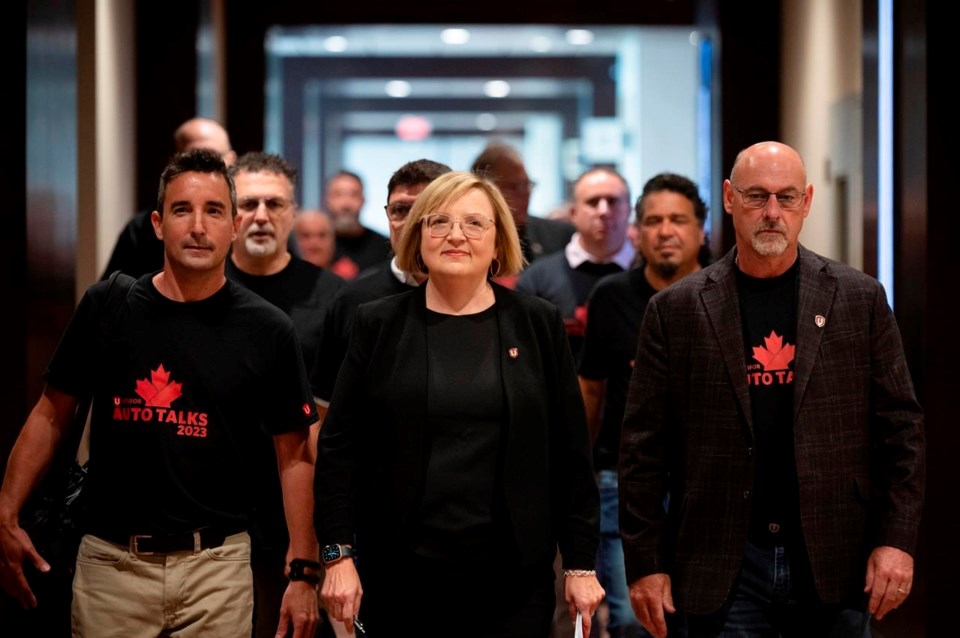TORONTO — Unifor reached a tentative deal with Stellantis after a brief strike Monday, setting the union up to wrap contract negotiations with the Detroit Three automakers.
The final deal, which still needs to be voted on by members, comes as U.S. autoworkers are also reported to have deals in place with all three automakers, which would bring to a close rounds of bargaining resulting in substantial wage gains on both sides of the border.
The United Auto Workers union has tentative deals in place with Ford, Stellantis and, according to three sources cited by The Associated Press, General Motors. The deals could bring to an end six weeks of strikes in the U.S. that have also strained Canada's parts supply sector.
Unifor secured its final deal with the Detroit Three after more than 8,200 Stellantis workers officially went on strike early Monday, only to be back at work by the afternoon shift.
"I'm very proud of our members at every Stellantis facility for their quick and decisive action during this brief, but effective, strike," said Unifor national president Lana Payne at a media briefing.
She said the union managed to secure the same pattern of economic benefits it has already reached with Ford and GM, despite resistance from Stellantis.
"There were many challenges in this round of bargaining, including flat out resistance to many elements of the pattern ... Stellantis came to the table aggressively and with demands to outsource work."
The union avoided outsourcing jobs in parts distribution as well as the elimination of jobs in the office and engineering units, said Payne.
On the question of unionization of the $5-billon battery plant Stellantis is developing with LG Corp., she said the company has committed to talking more about it as development continues.
"This agreement will considerably improve the living standards of every single Unifor member at Stellantis in Canada," said Payne.
It remains to be seen whether the deal is good enough for Stellantis workers, who will vote on the deal over the weekend.
Local 444 president Dave Cassidy in Windsor said ahead of bargaining that he'd heard from members that the contract template set during bargaining with Ford and GM wasn't good enough.
But on Monday morning, Cassidy said in a video on the local union's Facebook page that he was "very happy to bring back the deal" to members.
The union said Monday that the agreement with Stellantis follows the pattern agreement that will raise base hourly wages over the life of the three-year agreement by nearly 20 per cent for production workers and 25 per cent for skilled trades.
In addition, the pattern agreement includes improvements to all pension plans and two new additional paid holidays as well as other improvements.
Stellantis North America chief operating officer Mark Stewart said he was proud of the negotiating teams and thankful for their commitment.
"Once ratified, this agreement will reward our 8,000 represented employees and protect the long-term health of our Canadian operations," Stewart said in a statement.
The tentative agreement covers workers at assembly plants in Windsor, Ont., and Brampton, Ont., a casting plant in Toronto and parts distribution centres in Mississauga, Ont., and Red Deer, Alta.
News of the deal is a relief to suppliers, said Flavio Volpe, head of the Automotive Parts Manufacturers' Association.
"We're glad, especially, with today's news, that the union has reached a deal with Stellantis," he said, noting that upwards of 15,000 people work in factories that rely on those plants.
Volpe said there had been anxiety that the rolling work stoppage strategy being used by the UAW could come to Canada as well, a tactic that saw Canadian suppliers having to reduce output and temporarily cut back on their workforces.
The U.S. strikes brought disruption just as the industry was working to recover from component shortages, said Volpe.
"We're happy that it looks like it's over," he said.
The deals hold big wage gains for workers, with gains of close to 20 per cent over three years in Canada and more than 30 per cent over close to five years in the U.S. when cost-of-living increases are included.
The gains, which in the U.S. especially were making up for concessions in past bargaining, could spur higher wages across the auto sector, said Sam Fiorani, vice-president of global vehicle forecasting at AutoForecast Solutions.
"By raising their pay, it should energize other factories that are not unionized to raise their pay. If they don't, then it gives unions on both sides of the border the opportunity to organize non-union factories."
Smaller suppliers could be hit harder by these pressures because of their more fragile finances, said Fiorani.
However, parts suppliers in Canada did manage to get through the bargaining with fairly limited disruption, he said.
"It was surprising to see the Canadian side go with as little interruption of production as possible, especially in the wake of the adversarial approach that the UAW has taken this year."
Parts suppliers, and the whole industry, benefited from friendlier relations thanks in part to work done at the Canadian Automotive Partnership Council table, which helps unions and industry learn about pressing issues and context, said Volpe.
"We do all the hard team Canada stuff at that table," said Volpe. "I think that's why, in part, we had a different tone between Unifor and the companies, than UAW and the companies."
— With files from Associated Press.
This report by The Canadian Press was first published Oct. 30, 2023.
Ian Bickis, The Canadian Press



